Growing tomatoes can be a fun pastime for new and experienced gardeners. Whether you have a sprawling garden or just a few pots across your deck, you can grow a tomato harvest with the right knowledge and care. This guide walks you through everything you need to know to grow the perfect tomatoes, from selecting the best to harvesting your crops.
Choosing the Right Tomato Varieties
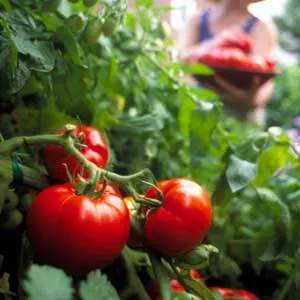
Selecting the right tomato varieties makes for a successful harvest. With countless options available, you need to factor in growth habits, disease resistance, and flavor when making your choice.
Determinate vs. Indeterminate Types
Tomatoes are classified as either determinate or indeterminate, each with distinct growth patterns and characteristics.
Determinate, or bush, varieties grow to a set height (typically 18 to 36 inches) and produce all their fruit within a concentrated period, usually four to six weeks. These plants are best for small spaces and container gardening. They don’t require staking and are perfect if you want to harvest your crop all at once for canning or sauce-making.
Indeterminate plants continue to grow, blossom, and produce fruit throughout the season until frost kills them. These plants can reach heights of three to six feet or more and require support systems. They offer continuous harvest, making them a good choice for gardeners who prefer fresh tomatoes over an extended period.
Disease-Resistant Cultivars
When browsing seed catalogs or plant labels, you’ll often see letters like V, F, N, T, and A after variety names. Choosing varieties with built-in disease resistance gives you a better chance of growing a healthier crop, especially if you’ve had disease issues in your garden before. These letters indicate resistance to common tomato diseases:
- V: Verticillium wilt
- F: Fusarium wilt
- N: Nematodes
- T: Tobacco mosaic virus
- A: Alternaria
Heirloom vs. Hybrid Tomatoes
Heirloom tomatoes are open-pollinated varieties that are most commonly grown in gardens. They’re known for their good flavor and unique appearance. “Brandywine” is a popular choice because of its balanced, fruity taste.
Hybrid tomatoes are created by crossing two different varieties to combine the best traits. They usually have better disease resistance, higher yields, and specific growth habits.
Preparing Your Garden for Tomato Success
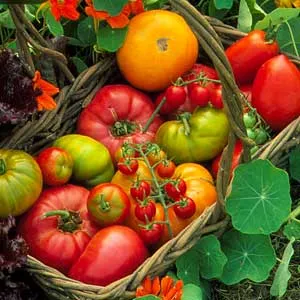
Proper preparation of your garden is important for growing healthy, productive tomato plants. This includes having the right soil conditions and choosing the best planting location.
Soil Preparation and pH Balance
Tomatoes thrive in well-drained soil rich in organic matter. Before planting, work two to three inches of compost or well-rotted manure into the top six inches of soil. This improves soil structure, drainage, and nutrient content.
Tomatoes prefer a soil pH between 6.0 and 6.8. If a soil test reveals your pH is below 6.0, add lime according to the test recommendations. Proper pH helps plants access the nutrients they need from the soil.
Selecting the Planting Site
Choose a location that receives at least eight hours of full sun daily. In very hot climates, some afternoon shade can be beneficial. Make sure your planting area has good air circulation to prevent disease issues.
Avoid planting tomatoes in the same spot every year, as this can lead to soil-borne diseases. Implement a crop rotation plan, waiting at least three years before planting tomatoes in the same spot.
Planting Techniques for Healthy Tomato Plants
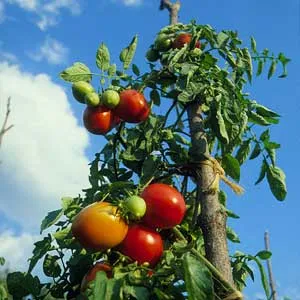
Proper planting techniques will provide you with tomato plants that produce fruit throughout the season. Timing, spacing, and planting depth all play a role in getting your tomatoes off to a strong start.
When to Plant Tomatoes
Plant tomatoes in the garden after the danger of frost has passed and soil temperatures have warmed above 60°F. In most regions, this is typically two to three weeks after the last frost date. Experienced gardeners sometimes plant earlier and use protective measures like row covers or wall-o-water devices to shield plants from late frosts.
Proper Spacing and Depth
Space determinate varieties about two feet apart, and indeterminate varieties about three feet apart. This spacing provides good air circulation to help prevent disease issues.
Plant tomato seedlings deeper than they were growing in their pots, burying the stem so that only the top cluster of leaves is above the soil line. Roots will develop along the buried stem, providing you with a stronger plant.
Transplanting Tips
When transplanting, gently remove seedlings from their containers, being careful not to disturb the roots. If plants are root-bound, gently loosen the root ball before planting.
Water the planting hole before setting in the seeding, then water again after planting to settle the soil around the roots. Apply a layer of organic mulch around the plants about a month after planting to help retain soil moisture and suppress weeds.
Important Care and Maintenance for Tomato Plants
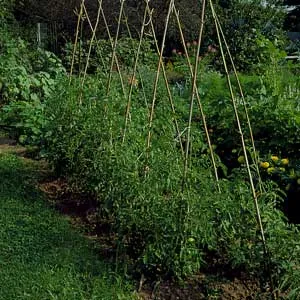
Proper care and maintenance are important for growing healthy, productive tomato plants. This includes adequate watering, nutrients, and supporting your plant throughout the growing season.
Watering Strategies for Tomatoes
Consistent soil moisture is key for tomato health. Provide about one inch of water per week, either from rainfall or irrigation. Water deeply and less frequently rather than giving plants frequent light waterings. To prevent disease issues, use water at the base of plants and avoid wetting foliage. Mulching around plants helps retain moisture and reduce evaporation.
Fertilizing Schedule and Methods
At planting time, apply a starter fertilizer solution. Mix two tablespoons of a balanced fertilizer per gallon of water and apply about one pint of this solution around each plant. Once fruits begin to form, side-dress plants with a balanced fertilizer every three to four weeks. Be careful not to over-fertilize with nitrogen, as this results in a lot of foliage but few fruits.
Pruning and Supporting Your Plants
Indeterminate varieties benefit from pruning to improve air circulation and focus the plant’s energy on fruit growth. Remove suckers (small shoots between the main stem and branches) when they’re two to four inches long.
Support indeterminate plants with sturdy stakes, cages, or trellises. Install supports at planting time to avoid damaging roots pater. For staked plants, tie the main stem loosely to the stake with soft twine or plant ties as it grows.
Combating Common Tomato Problems
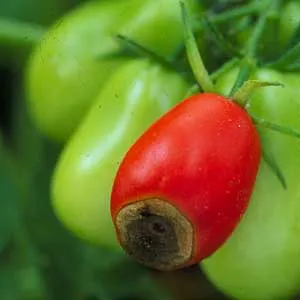
Even with the best care, tomato plants can face some challenges. Knowing how to identify and address common issues can help you achieve a successful harvest.
Identifying and Treating Diseases
Common tomato diseases include blossom end rot, fusarium wilt, and early blight. Blossom end rot appears as a dark, sunken area at the bottom of the fruit and is often caused by calcium deficiency due to inconsistent watering. To prevent diseases, remove and destroy any diseased plant material to prevent spread.
Managing Pests Effectively
Tomato hornworms are a common pest that can quickly affect plants. These large green caterpillars are well-camouflaged but can be hand-picked and removed. For infestations, use Bacillus thuringiensis(BT), a natural bacterial control.
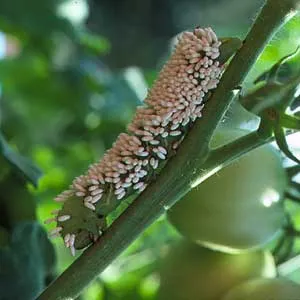
Addressing Nutrient Deficiencies
Yellowing leaves can indicate nutrient deficiencies. Magnesium deficiency often appears as yellowing between leaf veins on older leaves. A foliar spray of Epsom salts can help correct this issue.
Calcium deficiencies can lead to blossom end rot. Make sure you are watering consistently and add calcium-rich solutions like gypsum or crushed eggshells to the soil.
Harvesting and Storing Your Tomato Crop
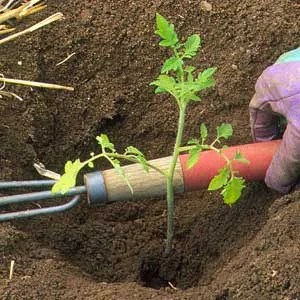
Proper harvesting and storage techniques will give you enjoyable, full-flavor tomatoes from your at-home garden.
Signs of Ripeness
Harvest tomatoes when they’re fully colored and slightly soft to the touch. The exact color at ripeness depends on the variety — most are red, while others may be yellow, orange, or purple.
Proper Picking Techniques
To harvest, gently twist the fruit while pulling slightly. The tomato should separate easily from the stem. For determinate varieties, harvest frequently as fruits ripen to encourage continued growth.
Storage Methods for Maximum Freshness
Store ripe tomatoes at room temperature, out of direct sunlight. Do not refrigerate tomatoes, as this can diminish their flavor and texture. If you have an abundance of ripe tomatoes, you can freeze, can, or make a sauce for long-term storage.
Advanced Tomato Growing Techniques
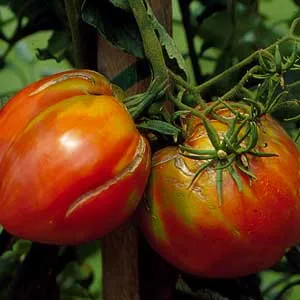
If you’re an experienced gardener and want to take your tomato plants to the next level, there are a handful of growing techniques you can implement into your routine.
Companion Planting for Tomatoes
Certain plants benefit tomatoes when grown nearby. Basil, for example, can improve tomato flavor and repel pests. Marigolds help deter nematodes, and carrots can loosen the soil for tomato roots.
Using Organic Mulches
Organic mulches like straw or shredded leaves help retain soil moisture, suppress weeds, and regulate soil temperature. Apply two to three inches of mulch around plants, keeping it away from the stem to prevent rot.
Implementing Crop Rotation
Rotate your tomato crop to a different area of the garden each year to prevent buildup of soil-borne diseases. Wait at least three years before planting tomatoes or related crops, like peppers or eggplants, in the same spot.

